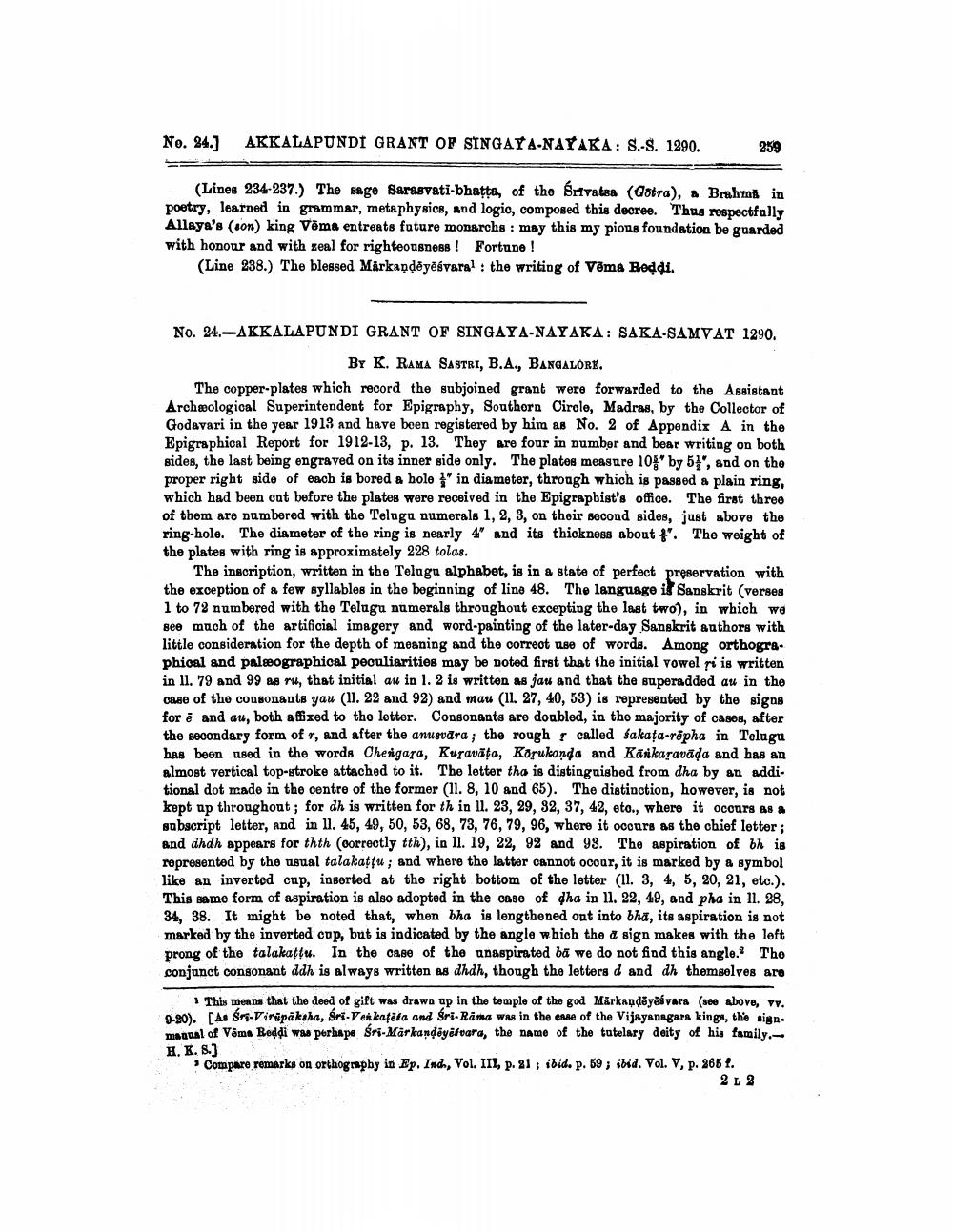________________
No. 24.7
AKKALAPUNDI GRANT OP SINGAYA-NAYAKA: S.-S. 1290.
259
(Lines 234-237.) The sage Sarasvati-bhatta, of the Srivatea (Gotra), a Brahmi in poetry, learned in grammar, metaphysics, and logio, composed this decree. Thus respectfully Allaya's (son) king Vēma entreats future monarchs : may this my pious foundation be guarded with honour and with zeal for righteousness! Fortune!
(Line 238.) The blessed Märkandēgēsyaral: the writing of Vöma Reddi.
No. 24.-AKKALAPUNDI GRANT OF SINGAYA-NAYAKA: SAKA-SAMVAT 1290.
BY K. RAMA SASTRI, B.A., BANGALORE. The copper-plates which record the subjoined grant were forwarded to the Assistant Archeological Superintendent for Epigraphy, Southern Circle, Madras, by the Collector of Godavari in the year 1913 and have been registered by him as No. 2 of Appendix A in the Epigraphical Report for 1912-13, p. 13. They are four in number and bear writing on both sides, the last being engraved on its inner side only. The plates measure 101" by 53', and on the proper right side of each is bored a hole " in diameter, through which is passed a plain ring, which had been cat before the plates were received in the Epigrapbist's office. The first three of them are numbered with the Teluga numerals 1, 2, 3, on their second sides, just above the ring-hole. The diameter of the ring is nearly 4" and its thickness about " The weight of the plates with ring is approximately 228 tolas.
The inscription, written in the Telugu alphabet, is in a state of perfect preservation with the exception of a few syllables in the beginning of line 48. The language it Sanskrit (verses 1 to 72 numbered with the Telugu numerals throughout excepting the last two), in which we see much of the artificial imagery and word-painting of the later-day Sanskrit authors with little consideration for the depth of meaning and the correot use of words. Among orthogra. phical and paleographical peculiarities may be noted first that the initial vowel ri is written in 11. 79 and 99 28 ru, that initial au in l. 2 is written as jau and that the superadded au in the case of the consonants yau (11. 22 and 92) and mau (11. 27, 40, 53) is represented by the signs for 7 and aus, both affixed to the letter. Consonants are doabled, in the majority of cases, after the secondary form of r, and after the anusvdra; the rough r called fakata-röpha in Telugu has been used in the words Chengara, Kuravăţa, Korukonda and Karikaravada and has an almost vertical top-stroke attached to it. The letter tha is distinguished from dha by an additional dot made in the centre of the former (11. 8, 10 and 65). The distinction, however, is not kept up throughout; for dh is written for th in 11. 23, 29, 32, 37, 42, eto., where it occurs as a subscript letter, and in 11. 45, 49, 50, 53, 68, 73, 76, 79, 96, where it occurs as the chief letter; and dhdh appears for thth (correctly tth), in 11. 19, 22, 92 and 98. The aspiration of bh is represented by the usual talakattu; and where the latter cannot ocour, it is marked by a symbol like an inverted cap, inserted at the right bottom of the letter (ll. 3, 4, 5, 20, 21, etc.). This same form of aspiration is also adopted in the case of dha in 11. 22, 49, and pha in 11. 28, 34, 38. It might be noted that, when bha is lengthened ont into tha, its aspiration is not marked by the inverted cop, but is indicated by the angle which the a sign makes with the left prong of the talakattu. In the case of the anaspirated bā we do not find this angle. The conjunct consonant ddh is always written as dhdh, though the letters d and dh themselves are
1 This means that the deed of gift was drawn up in the temple of the god Mārkanděyasvars (see above, vv. 9-20). [As sri-Virupaksha, Sri Venkatela and Sri-Rāma was in the case of the Vijayanagara kings, the signmanual of Vēma Reddi was perhaps Śri-Märkandēyetvara, the name of the tutelary deity of his family. H. K. S.] Compare remarks on orthography in Ep. Indh, Vol. III, p. 21, ibid. p. 69, ibid. Vol. V, p. 265 .
2 L 2




